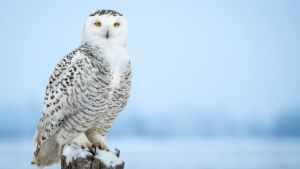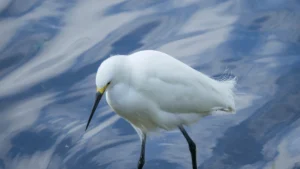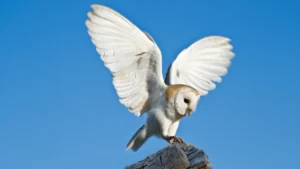What type of birds are actually white? The question that blew every bird watcher.
Well, there are plenty of white birds, but most of us usually think only about the common ones, such as White doves, White grey herons, and the aquatic bird-like swan.
But there are many more that seem fascinating!
In this article, we will Know the 15 purely white birds with an introduction and facts. We will also know about the luck of white birds and do their poop normal or not?
[su_animate type=”fadeInLeft” duration=”1.5″]So, let’s dive into our topic![/su_animate]
| WHAT IS THE NAME OF A WHITE BIRD?
What is a pure white bird? The list of the white birds’ names is so long.
Most people ask different birds for a white one, but actually, these birds are not purely white!
But we have got the 15 most unique white birds with information.
| WHAT IS AN EXAMPLE OF A WHITE BIRD?
Here is an example of the Top 15 birds that are entirely white with scientific names and introductions:
-
SNOWY OWL BUBO
| Scientific Name: scandiacus |
A large owl breeds in the Arctic regions of North America and Eurasia. Known for their distinctive white plumage and yellow eyes.

| Characteristic | Description |
| Weight | 1.6 – 3.5 kg (3.5 – 7.7 lb) |
| Wingspan | 1.3 – 1.5 m (4.2 – 4.9 ft) |
| Length | 52 – 71 cm (20 – 28 in) |
| Color | White with black spots |
| Habitat | Arctic tundra |
| Diet | Mainly lemmings, but also birds and small mammals |
| Lifespan | Up to 10 years in the wild, up to 35 years in captivity |
-
ARCTIC TERN STERNA
| Scientific Name: scandiacus |
A migratory bird that breeds in the Arctic and travels to the Antarctic each year, covering more than 44,000 miles in its annual migration. Its white plumage contrasts with its black cap and red bill.

| Characteristic | Description |
| Weight | 100 – 120 g (3.5 – 4.2 oz) |
| Wingspan | 76 – 85 cm (30 – 33 in) |
| Length | 28 – 39 cm (11 – 15 in) |
| Color | White/black cap and a red bill |
| Habitat | Arctic and subarctic regions |
| Diet | Fish and invertebrates |
| Lifespan | Up to 30 years in the wild |
-
WHOOPING CRANE
| Scientific Name: Grus americana |
An endangered bird native to North America, known for its striking white plumage and distinctive call. It is one of the tallest birds in North America.

| Characteristic | Description |
| Weight | 4.5 – 7.5 kg (9.9 – 16.5 lb) |
| Wingspan | 2.1 – 2.3 m (6.9 – 7.5 ft) |
| Height | 1.3 – 1.5 m (4.3 – 4.9 ft) |
| Color | White with black wingtips and a red patch on the head |
| Habitat | Wetlands, marshes, and prairies |
| Diet | Mainly small animals such as crabs, clams, frogs, and insects |
| Lifespan | Up to 24 years in the wild, up to 35 years in captivity |
-
SNOWY EGRET
| Scientific Name: Egretta Thula |
A medium-sized wading bird that breeds in North and South America. We know it for its bright white plumage, long black legs, and yellow feet.

| Characteristic | Description |
| Weight | 375 – 565 g (13.2 – 19.9 oz) |
| Wingspan | 88 – 104 cm (35 – 41 in) |
| Length | 56 – 66 cm (22 – 26 in) |
| Color | White feathers, black legs and bill, with yellow feet |
| Habitat | Shallow water habitats such as marshes, swamps, and tidal flats |
| Diet | Fish, crustaceans, and other small aquatic animals |
| Lifespan | Up to 17 years in the wild, up to 25 years in captivity |
-
GREAT EGRET
| Scientific Name: Ardea alba |
A large, white-wading bird found in many parts of the world, Like North America, Europe, Africa, and Asia. It has a long neck and a distinctive S-curved neck in flight.

| Characteristic | Description |
| Weight | 0.7 – 1.4 kg (1.5 – 3.1 lb) |
| Wingspan | 1.2 – 1.4 m (3.9 – 4.6 ft) |
| Length | 91 – 102 cm (36 – 40 in) |
| Color | White feathers, black legs and bill, with yellow feet |
| Habitat | Wetlands, marshes, and swamps |
| Diet | Fish, amphibians, reptiles, and small mammals |
| Lifespan | Up to 22 years in the wild |
-
BARN OWL
| Scientific Name: Tyto alba |
A medium-sized owl with a heart-shaped face is found in many parts of the world. Known for their pale, white feathers and excellent hearing.

| Characteristic | Description |
| Weight | 300 – 500 g (10.6 – 17.6 oz) |
| Wingspan | 80 – 95 cm (31 – 37 in) |
| Length | 33 – 39 cm (13 – 15 in) |
| Color | Pale golden-brown to grey feathers with white underparts, heart-shaped face |
| Habitat | Grasslands, agricultural fields, and open woodlands |
| Diet | Small mammals such as rodents, shrews, and rabbits, as well as insects and small birds |
| Lifespan | Up to 20 years in the wild |
-
LITTLE EGRET
| Scientific Name: Egretta garzetta |
A small, white egret found in Europe, Africa, and Asia. It has a slender body, a long neck, and black legs.

| Characteristic | Description |
| Weight | 350 – 550 g (12 – 19 oz) |
| Wingspan | 88 – 106 cm (35 – 42 in) |
| Length | 55 – 65 cm (22 – 26 in) |
| Color | White feathers, black legs and bill, with yellow feet and a dark patch on the back of the head |
| Habitat | Wetlands, marshes, and rice paddies |
| Diet | Small fish, amphibians, and invertebrates such as crustaceans and insects |
| Lifespan | Up to 10 years in the wild |
-
WHITE-TAILED EAGLE
| Scientific Name: Haliaeetus albicilla |
A large bird of prey found in Eurasia, known for its white tail and bright yellow beak. We also known it as the sea eagle.

| Characteristic | Description |
| Weight | 4 – 7 kg (8.8 – 15.4 lb) |
| Wingspan | 1.8 – 2.5 m (5.9 – 8.2 ft) |
| Length | 70 – 95 cm (28 – 37 in) |
| Color | Brown feathers with white tail feathers and yellow bill |
| Habitat | Coastal areas, wetlands, and large bodies of water |
| Diet | Fish, waterfowl, and small mammals |
| Lifespan | Up to 30 years in the wild |
-
WHITE-CROWNED SPARROW
| Scientific Name: Zonotrichia leucophrys |
A small songbird found in North America, known for its distinctive white and black striped crown.

| Characteristic | Description |
| Weight | 25 – 35 g (0.9 – 1.2 oz) |
| Wingspan | 20 – 23 cm (7.9 – 9.1 in) |
| Length | 15 – 18 cm (5.9 – 7.1 in) |
| Color | Grayish-brown back feathers, with black-and-white striped head and white throat and breast |
| Habitat | Open woodlands, scrublands, and suburban areas |
| Diet | Seeds, insects, and small fruits |
| Lifespan | Up to 8 years in the wild |
-
TRUMPETER SWAN
| Scientific Name: Cygnus buccinator |
A large, North American swan known for its deep, trumpeting calls. It has a long, graceful neck and a distinctive black beak.

| Characteristic | Description |
| Weight | 7 – 13 kg (15 – 29 lb) |
| Wingspan | 2.2 – 2.8 m (7.2 – 9.2 ft) |
| Length | 1.5 – 1.8 m (4.9 – 5.9 ft) |
| Color | White feathers, with black bill and legs |
| Habitat | Wetlands, lakes, and rivers in North America |
| Diet | Aquatic plants and occasionally small fish and invertebrates |
| Lifespan | Up to 24 years in the wild |
| IS WHITE BIRD RARE?
Generally, White birds are somewhat rare in nature, and certain species with predominantly.
White plumage can be considered rare, vulnerable, or even critically endangered.
Pure white feathering is an uncommon genetic trait that makes these birds more vulnerable, though some species can thrive at times or in specific locations.
White birds and white plumage have some advantages for camouflage and appearance.
White birds also tend to face more disadvantages relating to lack of camouflage, higher predation risk, difficulty finding food, and greater vulnerability for rare white morphs.
So, white birds can be considered ‘good’ in certain respects but also face challenges due to their coloration and rarity.
| ARE WHITE BIRDS / DOVES LUCKY?
White doves and pigeons are famous symbolic representatives of luck, peace, purity, and good fortune in many cultures, religions, and traditions.
We also know white birds as white birds of paradise because of their beauty
There is no objective evidence that they bring luck or positively tangibly influence prosperity and sound events.
The concept of white birds leading to luck is grounded in superstition, religious meaning, and cultural/wedding traditions – not proof of any actual causal effect on luck or fortune.
So white doves can be seen as a ‘lucky charm’ through symbolic meaning alone, not because they create or convey luck in and of themselves.
You should also know about the white bird symbol of peace and purity and also Discover the hilarious facts about the White Kite.
| IS WHITE BIRD POOP NORMAL?
Normal white bird poop is possible but somewhat uncommon for most species.
Pure white guano, or guano that is radically different from usual, is usually not normal and could indicate a health issue.
But some explanations for paler than average guano do exist and do not necessarily mean there is a problem.
Monitor your white-guano-producing birds, but do not assume there is a mechanical issue – some degree of lighter-colored droppings can indeed be average for specific birds, diets, or morphs.
Learn in detail about why is bird poop white!
| WHITE BIRDS VIDEO
| CONCLUSION
In conclusion, white birds are not only limited to doves, herons, and swans.
There are many unique and fascinating birds with striking white plumage. The article highlighted 15 birds, each with distinctive characteristics and habitats.
From the Arctic Tern to the Snowy Owl and the Whooping Crane,
White birds are not only beautiful but also crucial for their ecosystems. We should appreciate the beauty and diversity of these birds.
These birds are lovely and also a sign of peace and purity.
We hope you loved reading this!
[su_box title=”Suggested” style=”noise” title_color=”#fec201″]Here are our other masterpieces[/su_box]
